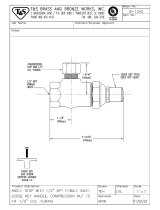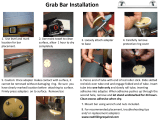14
5 MAINTENANCE
5.1 General Cleaning
Warning. Close all isolating valves before removing an
electrode from a flow line.
To ensure accurate monitoring, keep the electrodes free of
contaminants by periodic cleaning. The frequency of cleaning
depends on the particular application.
Automatic cleaning using the optional jetwash system and
controlling the cleaning solution using a suitable controller or
analyzer, will reduce the amount of manual cleaning.
Methods of removing various types of deposit are detailed
below. Replace the sensor if the performance of the sensor does
not improve after cleaning.
5.1.1 General Sludge and Loosely Adhering Matter
Rinse off the excess matter and wipe the sensor with a soft cloth
or tissue before calibrating.
5.1.2 Heavy, Non-Greasy Deposits
For example: lime, salts, etc.
Immerse the sensor in 1 to 2 M hydrochloric acid until the
deposit has dissolved. Rinse with demineralized water before
calibrating.
5.1.3 Greasy or Organic Deposits
Wipe the glass membrane with a detergent or acetone-based
solvent. Rinse with demineralized water before calibrating.
5.2 Fault Finding
Listed below are some common symptoms of sensor
malfunction together with possible cures.
Short scaling ( Low Slope ) or sluggish response
1) Glass sensor membrane dirty or coated – refer to Section 5.1
for cleaning.
2) Poor insulation on cable connectors, possibly due to
moisture – dry connectors with warm air.
Replace sensor if no improvement is seen. (It may also be
necessary to replace the extension cable if used.)
No response to pH buffer or sample
1) Sensor incorrectly connected – see Section 3.1 and the
analyzer user guide for connection details.
2) Glass sensor membrane broken or cracked – replace
sensor.
Unstable readings or drift
1) Sensor incorrectly connected – see Section 3.1 and the
analyzer user guide for connection details.
2) Dry or dirty reference junction – clean junction as detailed in
Section 5.1. Leave to soak in a buffer solution for several
hours.
Replace sensor if no improvement is seen.
Stable but incorrect readings
1) Incorrect calibration – recalibrate using fresh buffer solutions.
2) Incorrect temperature compensation settings – enter correct
manual temperature or check that automatic temperature
compensation is reading correctly.
3) Sensor responds correctly to pH changes, but there is an
offset of <1.0 pH and >0.2 pH – perform a one-point process
calibration – see Section 4.1.
Note. All the above symptoms could be caused by a
faulty extension cable. Check and replace it, if
necessary.
5.3 Storing the Electrode
Note. Allowing the glass membrane and reference
junction to dry out irreversibly affects the response of
the electrode.
If it is necessary to remove the electrode from the sample line, fill
the retained protective cap with buffer solution and cotton wool,
or equivalent, and fit it to the sensor.
























